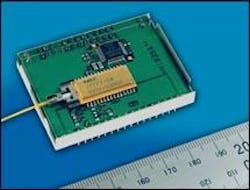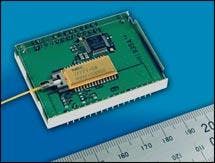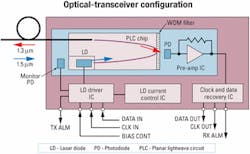The price is right: Winning the access game for components
Broadband deployment requires lower-cost technology that allows service providers to realize a rapid return on their investments.
DR. BOB SHINE, WaveSplitter Technologies and YOSHITAKA MORIMOTO, NEC FiberOptechApplications for faster broadband connections to the home exist today, whether sending digital photos, faster Internet access, telecommuting, or entertainment such as high-definition television or online gaming. While DSLs or cable modems can help, most Americans either don't have access to these high-speed connections or are unwilling to pay the costs. Similarly, emerging broadband applications to the business, such as videoconferencing to reduce travel expenses, warrant higher-speed connectivity from network service providers. But after spending tens of billions of dollars building high-capacity backbone networks, service providers are very cautious about any capital expenditure. Cost is a critical element of success for any broadband deployment, whether to the business or home.
Carriers are still spending money, an estimated $56 billion for wireline capital expenses in the United States and $123 billion globally in 2002.1 The criteria for this spending now includes a rapid return on investment. This criterion is in addition to other factors like improving reliability, reducing maintenance costs, accommodating future bandwidth upgrades, and allowing flexible deployment of services.
Capital spending in the access network, alternately known as the first mile or last mile, can offer rapid revenue generation if the services can be priced appropriately. Some analysts speculate that investment in access technology may lead service providers to new revenue sources, which in turn will drive more traffic into the network core and help pull the telecommunications industry out of its current slump.
PON-dering the solutionsA number of technologies can increase bandwidth in the access segment, from DSL and cable modems to fixed wireless and fiber-optic point-to-point or passive optical networks (PONs). While DSL and cable modems are popular choices today, they face fundamental bandwidth limitations, and installation and maintenance are often more complex than desired due to aging copper infrastructure and cable's sensitivity to electromagnetic noise. Fixed wireless does have an advantage in deployment but again is limited in spectrum and bandwidth and may be subject to environmental factors. Fiber-optic networks, either point-to-point solutions for business applications or PONs for shared residential applications, meet all the criteria identified above.Fiber offers the greatest potential bandwidth. ATM PONs based on current standards operate at 622 Mbits/sec downstream and 155 Mbits/sec upstream; a 1.25-Gbit/sec standard is in development. The passive design of the network reduces maintenance costs and improves reliability, and the high split-ratio design of PONs allows flexible deployment, which can accommodate churn.
A schematic of a PON that supports a range of services and various fiber-to-the-x (FTTx) applications is shown in Figure 1. While the optical line terminal, splitter/coupler, and fiber all contribute to the system cost; it is the optical-network unit (ONU) that dominates the cost. An ONU must be located at every customer site, and its costs cannot be shared over multiple users. In fiber-to-the-business or fiber-to-the-home (FTTH) deployments, ONU costs account for 70-80% of the total system cost.2 To make PONs economically justifiable, vendors must reduce the cost of ONUs.In a PON, the ONU receives the downstream broadcast signal transmitted at 1.5 microns, and transmits the upstream burst-mode signal at 1.3 microns, which allows the use of a single fiber for bidirectional traffic. Figure 2 shows a transceiver configuration for an ONU. In this schematic, a planar-lightwave-circuit (PLC) chip acts to separate or combine the 1.3- and 1.5-micron signals. A photodiode receives the downstream signal and amplifies and pro cesses the data, while the upstream data is sent via a laser diode transmitting at 1.3 microns.
Lowering the ONU's cost
Reducing the cost of the ONU requires improvements across a number of disciplines, particularly with regard to the design of the ONU transceiver. For a vendor to be able to offer low-cost products and deliver the volumes needed when the market develops, several courses of action are needed:
- Participate in standards bodies. Most vendors agree that for ATM-PON, Ethernet-PON, or point-to-point architectures, standard system specifications are key to the development of low-cost systems through the economics of mass production. For a vendor to leverage the economies of scale, it is critical that they participate actively in the standards bodies such as the Full Service Access Network (FSAN) working committee.
- Offer a broad product range. While a customer's system may target a particular network architecture, vendors can leverage both technology and volumes across product types, reducing component costs. The PLC element in Figure 2 was not developed for the ONU product but for another transceiver type. The vendor, however, was able to reduce costs by applying this technology to multiple products.
- Reduce costs through automation. At the anticipated volumes for access-network elements, automation is critical to address the required costs. Of course, the layout of the electrical elements can be done through pick-and-place automation. More difficult, but also required for cost reduction, is the passive alignment of the optical elements such as the fiber and laser diode.
- Ensure the reliability of the product. Just as automation is critical in reducing the component cost, automated testing reduces the product cost while also improving reliability. The full range of operating conditions can be tested to validate operation.
- Have a strong research and development capability. While many of the product features will be defined by standards, these specifications will likely trail users' demands. To meet carrier needs, it is important that component vendors work closely with customers to develop leading edge capabilities. Today, ATM-PON standards are defined for data rates of 155 Mbits/sec and 622 Mbits/sec, but carriers are looking for systems offering 1.25 Gbits/sec. Similarly, the standard transmission distance for a transceiver is 20 km, but longer reach is desired.
While it is likely vendors can reduce the cost of the ONU and other components, a criticism often leveled at last mile fiber solutions is the cost to deploy the fiber. Nevertheless, many greenfield applications today use fiber-to-the-building or FTTH, because the cost of fiber roughly equals the cost of coaxial cable once the trench is dug and the benefits of fiber greatly outweigh those of coaxial cable. Despite these inroads, it can cost upwards of $150,000 per mile to dig a trench to lay a fiber in an established neighborhood.3
Funding fiber build-outs
While service providers often cannot justify the fiber deployment costs to deliver bundled services for which customers may pay $100 per month, a number of governments view fiber optics as critical to their infrastructure development projects. Recently, the Irish government announced it will invest 300 million euros to build 50,000 km of high-speed fiber-optic Internet access rings around 123 towns and cities.4 With the Irish government absorbing the build-out costs, the service providers will not have to recoup capital costs for the network. Sweden has also invested in the development of broadband infrastructure, partially subsidizing the installation costs. Households willing to pay part of the installation costs can receive FTTH for roughly the same price America Online costs subscribers in the United States. In addition, incumbent carrier NTT has been actively involved in the development and deployment of PON in Japan since 1994.
In the United States, the state of Michigan passed the Broadband Development Act, which issues state-backed bonds and attractive 20-year loans to public and private entities for fiber build-outs.5 Universities, schools, libraries, and state government offices are viewed as "anchor tenants" to stimulate demand for broadband services. These anchor tenants create a guaranteed level of income for the carriers, with the possibility of long-term contracts. That greatly reduces the deployment and investment risk for the carriers.
Clearly, the market for access bandwidth exists. We must continue to invest at the component level, reducing cost while improving performance, to allow a broader penetration of fiber into the access network.
References
- "Morgan Stanley Global Carrier Capex Update," March 27, 2002.
- "Ethernet Passive Optical Networks," Web ProForum Tutorials, p. 8, www.iec.org.2.
- R. Kirby, "Fiber-Can't Find Its Way Home?" Network Magazine, Sept. 5, 2001.
- Wired News, March 19, 2002, http://www.wired.com/news/wireless/0,1382,51105-2,00.html.
- http://www.michigan.gov/gov/1,1431,7-103-703-20210-M_2002_3,00.html.
Dr. Bob Shine is the director of marketing at WaveSplitter Technologies Inc. (Fremont, CA) and Yoshitaka Morimoto is president of NEC FiberOptech Inc. (Cupertino, CA), a subsidiary of NEC.



